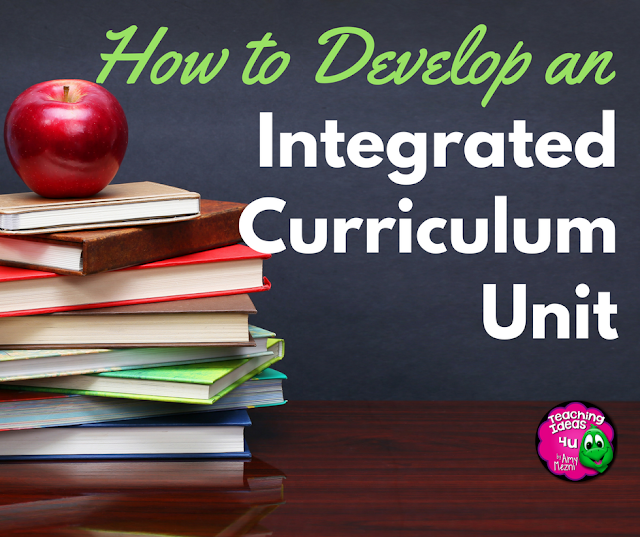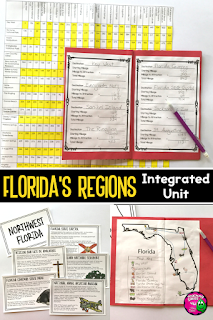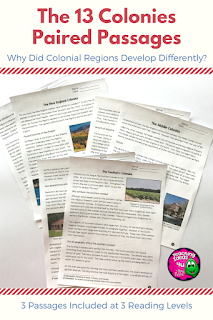How to Develop an Integrated Curriculum Unit
[et_pb_section bb_built="1"][et_pb_row][et_pb_column type="4_4"][et_pb_text _builder_version="3.19.4"]
Designing an integrated curriculum unit can seem overwhelming. Integrated instruction incorporates different disciplines in a lesson or unit of study. Just learning the curriculum for a grade level or class can be time-consuming, let alone figuring out how to teach different subjects in the same unit. However, for me, finding connections between subject areas really helps me to feel better prepared - and less overwhelmed knowing I can cover multiple standards in one unit. I think of integration as the magic power that stops students from asking that irritating question. You know, "Why do we need to learn this? When are we ever going to need this?' With integration, they know right away how they will use the skills they are learning! By the end of this article, I will explain both how to develop an integrated curriculum unit and show some examples of units I have created.
Developing an Integrated Curriculum Unit
ConnectEd has a ten step breakdown for creating integrated curriculum.
1. Connect with other teachers and industry professional to identify authentic connections between disciplines.
Don't forget non-profits and government agencies. I have had the CSI from our local police department come, as well as a representative from the Department of Agriculture.
2. Examine the existing scope and sequence of the classes to find standards that fit together or overlap.
Many math and science standards complement each other, as well as language arts and social studies. That is why those subjects are usually integrated. However, it is possible to integrate any of the core subjects with the right topic. Don't forget to include non-core subjects, too!
3. Select an overarching topic or theme.
Be creative! The home economics teacher and I developed an entire unit based on cotton. We not only taught standards in both her class and American history, but students also had time to develop a business selling t-shirts. Another year, the math and science teachers worked with me to create a unit on geocaching. A theme won't necessarily be an immediate topic in one of your classes.
4. Create your essential questions and identify key questions.
This step is often overlooked, but it is important that teachers know where they want students to be at the end of the unit. What skills should they have acquired? What should they know? Without these questions, teachers can easily end up with "fun" lessons that don't address the standards.
5. Identify and assign roles and responsibilities for each team member in charge of creating the curriculum.
If you have ever done group projects in your class, you know how important this step is. The team needs to decide up front who will do which pieces of the plan and when the work needs to be done.
6. Revisit your curriculum map and make any sequencing adjustments needed.
Double check - are the lessons being taught in the order that makes the most sense?
7. Plan how you will introduce the unit.
Basically, you need a hook. Sometimes the hook is easy. CSI was an extremely popular TV show when I created my mystery unit. Other times, teachers need to create the buzz.
8. Create student assessments, including both formative and summative ones.
Again, teachers need to make sure that they are designing a project that incorporates the skills students are learning. Lessons should scaffold students' skills so that the can be successful on the culminating project. be sure to develop assessments throughout the unit to double check students' understanding.
9.Create lesson plans for the unit.
I like the Units by Design Lesson Plan process. You can find a link to my blog post on UBD at the end. However, if your district requires a certain format, then be sure to use that one.
10. Reevaluate the unit.
Reevaluate one last time before teaching it, and again when you are done. Make any changes that your team feels are needed to make the unit better.
Examples of Integrated Curriculum
Still wondering how to integrate curriculum in your classroom? Here are some examples of integrated resources I have made. Hopefully they will give you some ideas fro making units for your class. if you would like to purchase completed units, these and others are available in my store.
Planning a Trip Through Florida's Regions
This product integrates math, writing, and geography. Students conduct research and write journal entries on a pretend trip through Florida's regions. They also map their trip and calculate the mileage. In just one project, students practice skills in three subjects!
The 13 Colonies Paired Passages
For our state writing test, students are expected to integrate information from multiple sources in an essay. Finding appropriate texts on the same reading level and on similar topics can be a challenge, so I began making my own. These passages meet both social studies and language arts standards. Teachers can cover informational text reading skills and essay writing while covering their history standards!
Colonial American Flipbook
These units were born of a need for short informational texts that worked as a unit in social studies. Again, I wanted to create a social studies unit that would also work for a language arts block. This unit teaches a reading skill and reviews it within the unit. Students also create a timeline using information from the texts. Related posts: How to Develop a Unit Plan - includes a unit planning template and sample unit. Also make sure to read How to Use Differentiated Instruction How do you use or want to use integrated curriculum in your classroom?
[/et_pb_text][et_pb_image admin_label="Image - Dotted Line" _builder_version="3.17.6" src="https://teachingideas4u.com/wp-content/uploads/2017/11/AmyMezniBranding-Divider1-1.png" align="center" saved_tabs="all" /][et_pb_text admin_label="Text - Section Header - Resources" _builder_version="3.17.6" saved_tabs="all"]
Looking for Teaching Resources?
[/et_pb_text][et_pb_dmpc_product_carousel _builder_version="3.19.4" product_type="best_seller" /][/et_pb_column][/et_pb_row][/et_pb_section]




